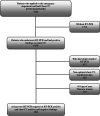RSNA and BSTI grading systems of COVID-19 pneumonia: comparison of the diagnostic performance and interobserver agreement
- PMID: 34602051
- PMCID: PMC8487757
- DOI: 10.1186/s12880-021-00668-3
RSNA and BSTI grading systems of COVID-19 pneumonia: comparison of the diagnostic performance and interobserver agreement
Abstract
Background: This study aimed to compare the performance and interobservers agreement of cases with findings on chest CT based on the British Society of Thoracic Imaging (BSTI) guideline statement of COVID-19 and the Radiological Society of North America (RSNA) expert consensus statement.
Methods: In this study, 903 patients who had admitted to the emergency department with a pre-diagnosis of COVID-19 between 1 and 18 July 2020 and had chest CT. Two radiologists classified the chest CT findings according to the RSNA and BSTI consensus statements. The performance, sensitivity and specificity values of the two classification systems were calculated and the agreement between the observers was compared by using kappa analysis.
Results: Considering RT-PCR test result as a gold standard, the sensitivity, specificity and positive predictive values were significantly higher for the two observers according to the BSTI guidance statement and the RSNA expert consensus statement (83.3%, 89.7%, 89.0%; % 81.2,% 89.7,% 88.7, respectively). There was a good agreement in the PCR positive group (κ: 0.707; p < 0.001 for BSTI and κ: 0.716; p < 0.001 for RSNA), a good agreement in the PCR negative group (κ: 0.645; p < 0.001 for BSTI and κ: 0.743; p < 0.001 for RSNA) according to the BSTI and RSNA classification between the two radiologists.
Conclusion: As a result, RSNA and BSTI statement provided reasonable performance and interobservers agreement in reporting CT findings of COVID-19. However, the number of patients defined as false negative and indeterminate in both classification systems is at a level that cannot be neglected.
Keywords: Computed tomography; Coronavirus; Guidelines of radiology; RT-PCR.
© 2021. The Author(s).
Conflict of interest statement
There is no conflict of interest in this study.
Figures







Similar articles
-
Radiological Society of North America (RSNA) Expert Consensus Statement Related to Chest CT Findings in COVID-19 Versus CO-RADS: Comparison of Reporting System Performance Among Chest Radiologists and End-User Preference.Can Assoc Radiol J. 2021 Nov;72(4):806-813. doi: 10.1177/0846537120968919. Epub 2020 Nov 3. Can Assoc Radiol J. 2021. PMID: 33138634
-
Comparison of Chest CT Grading Systems in Coronavirus Disease 2019 (COVID-19) Pneumonia.Radiol Cardiothorac Imaging. 2020 Nov 5;2(6):e200492. doi: 10.1148/ryct.2020200492. eCollection 2020 Dec. Radiol Cardiothorac Imaging. 2020. PMID: 33778648 Free PMC article.
-
RSNA Expert Consensus Statement on Reporting Chest CT Findings Related to COVID-19: Interobserver Agreement Between Chest Radiologists.Can Assoc Radiol J. 2021 Feb;72(1):159-166. doi: 10.1177/0846537120938328. Epub 2020 Jul 2. Can Assoc Radiol J. 2021. PMID: 32615802 Free PMC article.
-
Thoracic imaging tests for the diagnosis of COVID-19.Cochrane Database Syst Rev. 2020 Sep 30;9:CD013639. doi: 10.1002/14651858.CD013639.pub2. Cochrane Database Syst Rev. 2020. Update in: Cochrane Database Syst Rev. 2020 Nov 26;11:CD013639. doi: 10.1002/14651858.CD013639.pub3. PMID: 32997361 Updated.
-
Thoracic imaging tests for the diagnosis of COVID-19.Cochrane Database Syst Rev. 2020 Nov 26;11:CD013639. doi: 10.1002/14651858.CD013639.pub3. Cochrane Database Syst Rev. 2020. Update in: Cochrane Database Syst Rev. 2021 Mar 16;3:CD013639. doi: 10.1002/14651858.CD013639.pub4. PMID: 33242342 Updated.
Cited by
-
Do COVID-19 CT features vary between patients from within and outside mainland China? Findings from a meta-analysis.Front Public Health. 2022 Oct 14;10:939095. doi: 10.3389/fpubh.2022.939095. eCollection 2022. Front Public Health. 2022. PMID: 36311632 Free PMC article.
-
Diagnostic performance of standardized typical CT findings for COVID-19: a systematic review and meta-analysis.Insights Imaging. 2023 May 24;14(1):96. doi: 10.1186/s13244-023-01429-2. Insights Imaging. 2023. PMID: 37222857 Free PMC article.
References
-
- ACR Recommendations for the use of Chest Radiography and Computed Tomography (CT) for Suspected COVID-19 Infection. https://www.acr.org/Advocacy-and-Economics/ACR-Position-Statements/Recom.... Accessed 1 April 2020.
Publication types
MeSH terms
LinkOut - more resources
Full Text Sources
Medical
Research Materials

